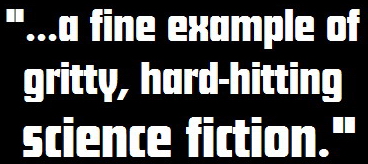|
| |
|
STORY PLACEMENT THIS STORY TAKES PLACE BETWEEN THE NOVELS "DECEIT" AND "WHITE DARKNESS."
WRITTEN BY ANDY LANE & JIM MORTIMORE
RECOMMENDED PURCHASE OFFICIAL VIRGIN 'NEW ADVENTURE' PAPERBACK (ISBN 0-426-20388-7) RELEASED IN MAY 1993.
BLURB Ace is back. And she is not in a good mood.
Bernice has asked the Doctor to bring the TARDIS to the planet OF Lucifer, site of a scientific expedition. It’s history to her: the exploration of alien artefacts on Lucifer came to an abrupt halt three centuries before she was born, and she’s always wondered why.
FINDING the answer involves the Doctor, Bernice and Ace in sabotage, murder and the resurrection of eons-old powers.
Lucifer? And what does it all have to do with Ace? |
|
|
Lucifer Rising MAY 1993
Much like the previous novel, this is an adventure that will grip you from start to finish. Lucifer Rising deals with Ace’s return and her subsequent manipulation of the Doctor - her ‘vengeance’, if you will, for the hell that he put her through on Heaven, not to mention so very many times before.
The story itself is a fine example of gritty, hard-hitting science fiction. The authors describe Lucifer and the Eden Project in such vivid detail that its world becomes real; the reader is completely immersed in it and as such is free to follow the ‘whodunit’ plot that runs through the first two thirds or so of the book and to really focus on what is at the heart of the book: strained relationships. Mothers and daughters, husbands and wives, fathers and daughters, Doctors and Aces.
“I don’t hate you Ace. I hate what you’ve become.”
As the narrative unfolds, it becomes clear that Ace rejoined the TARDIS crew at the end of Deceit because the Interplanetary Mining Corporation - the company that she served during the Dalek War - gave her a secret mission to carry out, should she ever be given the chance to time-travel again. World-weary, selfish and even a bit twisted, Lane and Mortimore’s Ace makes for some absolutely spellbinding reading, particularly as for a great deal of this novel she is firmly sat on the wrong side of the fence. This is particularly interesting as Bernice is not attached to Ace in the same way that the Doctor is, and accordingly is far less forgiving of her betrayal.
What’s more, the resolution of the novel is nothing short of thrilling. Often in Doctor Who you can see exactly how the reset button is going to be pressed and the world saved, but thanks to Ace’s knowledge of what happens to the Lucifer system, we know that isn’t on the cards here. The question becomes less ‘will our heroes save the day?’, and more one of ‘how are our heroes going to survive...?’
“Welcome to Hell, Legion.”
Controversially, the Doctor regains Ace’s loyalty by doing his own dirty work for a change, shooting IMC’s extradimensional leader, Legion, in cold blood. In the context of the story this works spectacularly, precisely because it goes directly against the Doctor’s character. His killing of Legion is an epiphany for him, as he realises that by manipulating people into doing his bidding (which habitually involves dishing out death) he was being a coward and his hands were every bit as blood-stained as those which pulled the triggers for him. This is perhaps the biggest character development since the juggling, spoon-playing jester began his journey towards becoming “Time’s Champion”.
A final masterstroke sees the Doctor use the Angels’ morphic field manipulator to join himself to Ace and Benny as only together, working as one, can they undo the damage caused by IMC and misguided scientist Alex Bannen. Whilst merged, we are treated to fascinating glimpses of their minds. We see Ace confront Jan, Bernice face her father, and the Doctor revisit the old Hermit from Planet of the Spiders.
Some will balk at the authors’ propensity for fanwank, the continuity references that I’ve just mentioned being the mere tip of the iceberg. In fact, I think you’d be hard-pressed to find a novel as littered with gentle winks and nods as this one is. Most noticeably, the characters here address each other using ‘Trau’ and ‘Krau’ (as seen in The Caves of Androzani); we are presented with yet another theory to explain why most races in the cosmos seem to be humanoid; we learn that Adjudicators will eventually become the Grand Order of Oberon; hear mention of the Rills, the Macra, and even Kroagnon; not to mention pay witness to the plague that will foreshadow the Dalek Invasion of Earth! But, though they can seem a little wanton whilst reading, I think that if certain organisations, races, starships and events have to be referred to either to further the storyline or just for world-building, then why not refer to some that have already been established, and help engender a little permanence? Other shows certainly do it – just look at Star Trek. …
The only real fault that I can find with this book though is its sheer length; it seems to suffer from padding in parts that is reminiscent of the old six or even seven-parters on television. All the same, Lucifer Rising is a watershed novel in so many ways, not just for the Doctor
but for Ace,
and even for Benny. This is a must-read New Adventure.
|
|
|
Copyright © E.G. Wolverson 2006
E.G. Wolverson has asserted his right under the Copyright, Designs and Patents Act, 1988 to be identified as the author of this work. |
|
|
Unless otherwise stated, all images on this site are copyrighted to the BBC and are used solely for promotional purposes. ‘Doctor Who’ is copyright © by the BBC. No copyright infringement is intended. |
|

.jpg)
.jpg)
 Andy
Lane and Jim Mortimore’s novel is notably longer than most of the New
Adventures, and what’s
more, like the two
preceding novels, it is divided up into “parts” that mimic episodes of the
television series (though, unlike both The Pit and Deceit,
it does at least break them up into bitesize chapters). Lucifer Rising
is also illustrated in the same way that the old Target
novelisations often were: several stunning, greyscale sketches from Lee Brimmicombe-Wood accompany the text, really setting
this adventure
apart from its peers and marking it out as something a bit special.
Andy
Lane and Jim Mortimore’s novel is notably longer than most of the New
Adventures, and what’s
more, like the two
preceding novels, it is divided up into “parts” that mimic episodes of the
television series (though, unlike both The Pit and Deceit,
it does at least break them up into bitesize chapters). Lucifer Rising
is also illustrated in the same way that the old Target
novelisations often were: several stunning, greyscale sketches from Lee Brimmicombe-Wood accompany the text, really setting
this adventure
apart from its peers and marking it out as something a bit special. 